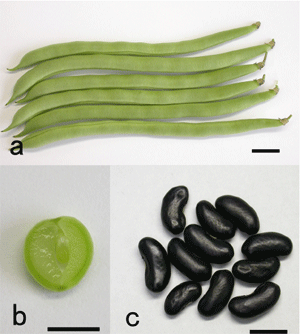Development of “Naribushi,” a new variety of snap bean (Phaseolus vulgaris L.) resistant to hightemperature stress
Description
In Okinawa, temperate vegetables are difficult to cultivate during May to October, when mean monthly air temperature exceeds 25℃. This has prompted JIRCAS to work on developing new vegetable varieties that are resistant to high-temperature stress by evaluating and utilizing crop germplasm accessions collected from tropical areas. Snap bean (Phaseolus vulgaris L.) is very prone to high-temperature stress, which causes pollen sterility, leading to flower abscission and a decrease in pod yields. By screening snap bean germplasm accessions based on successful pod setting under hot conditions in the field, JIRCAS successfully developed a heat-tolerant variety, “Haibushi,” which was registered as Norin No. 1 in 1995.
A new variety, “Naribushi” (“shooting star” in Okinawan), was also developed by selecting germplasm accessions for heat tolerance originally collected from Malaysia in 1985 by the Tropical Agriculture Research Center (now reorganized into JIRCAS). “Naribushi” develops a long, round pod of a light green color (Fig. 1), while “Haibushi” develops a short and flat pod. The Brix value is 4.9 in “Naribushi,” the same as that for “Haibushi” and much higher than the 3.9 seen in “Kentucky Wonder” (a standard variety). Thus, the eating quality of “Naribushi” is high.
Pod setting of “Naribushi,” “Haibushi,” and “Kentucky Wonder” at a mean air temperature of 24oC was high, at 83.3%, 82.6%, and 85.3%, respectively. Even under high-temperature conditions (a mean air temperature of 28oC), pod setting of “Naribushi” and “Haibushi” were relatively high at 68.3% and 70.1%, although that of “Kentucky Wonder” declined sharply to 23.3%. “Naribushi” can produce about 1.6 to 1.8 ton of pods per 10 a under hightemperature conditions, indicating that it is suitable for summer cultivation in Okinawa (between May and July, before the typhoons arrive).
We have applied to Japan’s MAFF to register this new variety. “Naribushi” is also anticipated to be used in breeding programs to increase the diversity of snap bean varieties in tropical and subtropical areas by incorporating heat tolerance into other cultivars with good pod characteristics, high yielding capabilities, etc.
Figure, table
-
Fig. 1. Pods and seeds of “Naribushi.”
a) Pods of “Naribushi” 14 days after flowering
b) Cross-section of the middle of a young pod
c) Mature seeds of “Naribushi”
Note: The bar shows 1 cm.
- Affiliation
-
Japan International Research Center for Agricultural Sciences Tropical Agriculture Research Front
- Term of research
-
FY2006(FY2001~2005)
- Responsible researcher
-
KASHIWABA Kouichi ( Tropical Agriculture Research Front )
EGAWA Yoshinobu ( Tropical Agriculture Research Front )
Omae Hide ( Tropical Agriculture Research Front )
MIERUKA ID: 001794Shono Mariko ( Tropical Agriculture Research Front )
MIERUKA ID: 001790 - ほか
- Publication, etc.
-
Variety registration (January 2006).
- Japanese PDF
-
2006_seikajouhou_A4_ja_Part22.pdf533.83 KB

